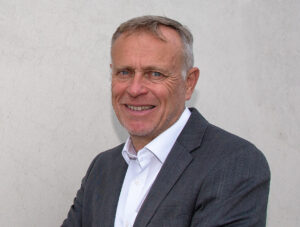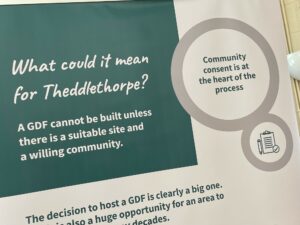Welcome to the seventh issue of the Theddlethorpe GDF Working Group Newsletter
This month we have been concentrating on moving to the next stage of the GDF process which is forming a Community Partnership. And as the Community Partnership is established, the Working Group and its activities will come to an end.
Why do we want to move to a Community Partnership? Mainly because it’s an opportunity to involve more local people in helping decide whether a GDF is right for the Theddlethorpe and Mablethorpe area.
Once set up the Community Partnership will be responsible for developing ‘a vision’ for the future of the area as well as overseeing the work necessary to decide whether building a GDF is technically and safely possible, deciding how and where Community Investment Funding should be spent and encouraging public debate about the pros and cons of the proposal.
Setting up a Community Partnership is required by the legislation covering the GDF evaluation process and its structure and starting membership have to be decided by the Working Group. At our last meeting the Working Group agreed a structure with a third of the Partnership members being drawn from the voluntary sector, a third from the business sector and a third from local authorities, with one each from the County Council, the District Council, Mableththorpe Town Council, and the Parish Councils. There will also be a Partnership Chairperson and a representative of Nuclear Waste Services (NWS) the body asked by Government to oversee the process.
All Community Partnership members will be expected to either live or work in the area and will be interviewed by a panel drawn from the Working Group to ensure they meet the job description and person spec for membership. However, once set up, how it runs, its membership and the decisions it takes will be for the Community Partnership itself to decide.
When the Community Partnership is up and running, £1million a year in Community Investment Funding will become available to spend locally on causes and projects to improve the area and providing new opportunities for local residents. This process will need to be overseen by a Grants Panel working with the Partnership’s Grants Manager and made up of members drawn from the Partnership and the local community.
We will be looking for local people keen to get involved with the work of the Community Partnership, so if you think that’s you, please check out our website once the Community Partnership is formed to see the opportunities.
Finally, as we continue to work towards setting up the Community Partnership, please continue to get in touch with us if you have any questions, issues, or concerns. Hundreds of local residents have already, and the Working Group very much welcomes your interest whatever your views.
And if like many of us, much of this is new to you, then our website is a handy resource. You’ll find all kinds of useful information there including an explanation of what a GDF is and why, wherever it’s built, scientists and government believe it’s needed.
There is also the latest news on what the Working Group is doing, how the technical evaluation is going and a handy section on “Frequently Asked Questions” with of course the answers.
You can also visit our Virtual Exhibition – an interactive digital experience to find out more information about geological disposal. Take a look, and if you have any questions then please contact us using the contact us form online or via email or telephone.
Best wishes,

Jon Collins
Independent chair of the Working Group
Out and about talking to people

Since launch last year, the Working Group’s Community Engagement team has met with and chatted to hundreds of people about geological disposal and what it could mean for Theddlethorpe and the surrounding area.
Twenty-three events have taken place and in total 845 people came along to these to find out more about the project – asking questions, giving their views, having detailed conversations, and taking away further information. Whilst at the events 307 people requested to receive this newsletter and be kept up to date about the GDF project.
These face-to-face contacts are in addition to the people who have viewed our virtual exhibition online and contacted us via telephone or email.
The team have been to 16 locations, in places such as Theddlethorpe, Mablethorpe, Trusthorpe, Withern, and Great Carlton, as well as venues in the villages just outside the Search Area. Many of which took place prior to the Search Area being announced back in February, with residents keen to know more about the GDF.
A variety of topics have been talked about and these have included – the Working Group itself, safety and security, geology, job opportunities, transport plans, what a Community Partnership entails, what Community Investment Funding is and what it can be used for.
Community Engagement Manager for the Working Group, Kate Atha, said:
“The series of exhibitions we have held in recent months has enabled us to speak to hundreds of people about the GDF programme and it’s been great to be able to do that: understandably people have lots of questions and I have been pleased that we have been able to start to answer some of these.”
“Local people have talked to us about a wide range of topics and issues, and we are so grateful that they have felt that they have been able to do so. Another stand out point of the events held to date for me is that people really appreciated having time to speak to experts in a calm and open way and I am pleased that visitors have been able to do that. More generally, I’d like to take this opportunity to thank everyone who has come along to these events.”
“However, it’s important to remember that we are at the start of a process and there will be many more opportunities for people to discuss all aspects of the GDF programme with us in the future. We’ll be in touch to tell you about these opportunities as they develop but, in the meantime, please do keep in touch with us using the details contained in this newsletter.”
The Environment Agency (EA) and the Office for Nuclear Regulation (ONR) are the independent regulators of the GDF and representatives from these organisations joined the engagement team at a couple of events in Mablethorpe. This was to allow people to see that the siting of the GDF will be strictly regulated throughout the whole process.
The subject of the safety of the GDF and the environmental impact were both topics that people wanted to talk about with us, and they were amongst other areas of interest that included local geology, transport, community impacts, property value, funding and community benefits and jobs.
There was a lot of information collected from these public events and here is just a small sample of the questions asked.
- What about the safety aspect of transporting and delivering of nuclear waste across the UK and to the site?
- How will it be protected from future drilling for other resources such as oil and gas in years to come?
- Where is the funding going to come from and what can it be used for?
- Why are the rocks in this part of the world the correct sort of rocks?
- What about the impact of climate change/rising sea waters on the project?
- Will it bring local jobs and opportunities for people?
And some of the statements from people:
“It’s a fascinating project from an engineering perspective, but I’m concerned about safety and safeguards.”
“Even though I understand that we can’t just leave it [the waste] where it is, I don’t think I’ll ever change my mind about it being dumped in Lincolnshire. Lincolnshire should be kept nuclear free.”
“Let’s face it, the word ‘nuclear’ frightens everyone to death, doesn’t it? But I just came to find out more about it … I want to make an informed choice.”
“Really interested in the infrastructure improvement opportunities. The area needs investment. Good idea it will bring jobs and money to the Mablethorpe area”.
What are the community benefits of a GDF?
This month we consider the community benefits of a Geological Disposal Facility (GDF). This could include millions of pounds of community investment funding which is triggered once a Community Partnership is formed, as well as significant additional investment, economic and employment opportunities for a community which eventually hosts a GDF.
The process of finding a suitable site for a GDF, somewhere in England and Wales, could take up to 15 years. Although that may seem a long way off, the multi-billion investment of a GDF would be transformational for an area.

Early benefits of forming a Community Partnership
As part of its role to start a conversation around GDF locally and identify a Search Area(s) – the Theddlethorpe GDF Working Group will begin to identify local people who may be interested in joining a Community Partnership – a group which will go on to consider possibilities in more detail. This partnership would also involve Nuclear Waste Services (NWS) and at least one relevant Principal Local Authority – such as the county or district council.
It’s at this point of forming a Community Partnership that community investment funding will be available for as long as the Community Partnership is part of the process.
 Communities will be at the heart of the siting process for a GDF and a facility will only be built where there’s both a suitable site and a willing community. The investment funding can be used before any commitment to a GDF, and communities can see benefits from engaging in the process whatever the outcome.
Communities will be at the heart of the siting process for a GDF and a facility will only be built where there’s both a suitable site and a willing community. The investment funding can be used before any commitment to a GDF, and communities can see benefits from engaging in the process whatever the outcome.
The role of the Community Partnership includes developing a vision for the future about how a GDF could benefit a community over the long term and what significant improvements people would like to see in their area.
Communities have an ongoing right of withdrawal from discussions and the local population must give consent to host a facility, through a test of public support, before a planning application can be made. Only following a positive test of public support and after the relevant permissions from the independent regulators and the Secretary of State have been obtained, could construction start.
Investment and creating jobs
Once a site has been eventually chosen for a GDF, investment in local infrastructure such as road, rail, power, and broadband networks would be needed to enable its construction and operation.
This significant additional investment will become available to the host community, and it will recognise the long-term commitment from this community. Investment could include improved local education and skills, recreational and community facilities and business opportunities.
This major infrastructure project would also bring hundreds of well-paid jobs every year for over a century in construction, engineering, safety, and project management (with the long lead-in time creating opportunity for the jobs and skills to be undertaken and developed by people in the community) plus further opportunities for the local supply chain.
Successful operation of a GDF could also require several facilities such as training and visitor centres, plus Research and Development, bringing additional employment.
Construction activities will continue throughout the operational lifetime of a GDF as the network of tunnels and vaults are extended stage by stage and a GDF will be receiving waste for more than a century.
When we understand more about a potential location, we will be able to develop a clearer picture about investment opportunities.
For a summary of community benefits, see this video – How a GDF can benefit a community: https://youtu.be/6irCmnoiIck
Your questions answered
Will a GDF be safe for people and the environment?
Yes – safety of a GDF is our number one priority and must be assured by independent regulators. A GDF will not be built unless we, and they, are satisfied it is safe and secure for present and future generations.
We can only build a GDF if we demonstrate to the UK’s independent nuclear and environmental regulators that people and the environment will be protected, both during construction, operation and in the long-term, following closure. We demonstrate this by presenting our scientific, technical and management evidence in a safety case. A GDF uses a multi-barrier approach to containment, relying not just on the engineering alone, but on its combination with naturally stable geology to provide a barrier in the very long term.
How do you approach safety?
We will have to demonstrate to the nuclear and environmental regulators that the GDF will be safe and secure before they will allow us to start construction. We will do this by presenting evidence in a safety case. NWS would also need to obtain a nuclear site licence and environmental permit, which means a GDF would be subject to same requirements for operational safety as any other nuclear site, as well as the requirements for long-term, post-closure safety of people and the environment. We meet regularly with the regulators to understand and address their requirements.
What research has been done to reassure the public of its safety?
Research has demonstrated that enough is known about geological disposal to proceed with confidence. There has been more than 30 years of research worldwide into the technical feasibility, scientific implications, and safety requirements of geological disposal. This research is published and openly available and has been extensively peer reviewed. You can find our safety reports on https://www.gov.uk/government/organisations/nuclear-waste-services
How does the rock provide safety?
The natural geological barrier isolates the waste from the surface and helps to contain the waste while its radioactivity decreases naturally over time. It works together with engineered barriers as part of a multiple barrier system to prevent hazardous levels of radioactivity from ever reaching the surface environment.
Different rock types have different properties, and so the engineered barriers will be designed to complement the substantial natural barrier provided by depth and type of rock above, around and within the underground facility.
You can find more questions and answers like these on our website.
Our Frequently Asked Questions (FAQs) are there to help you learn more about the GDF.

